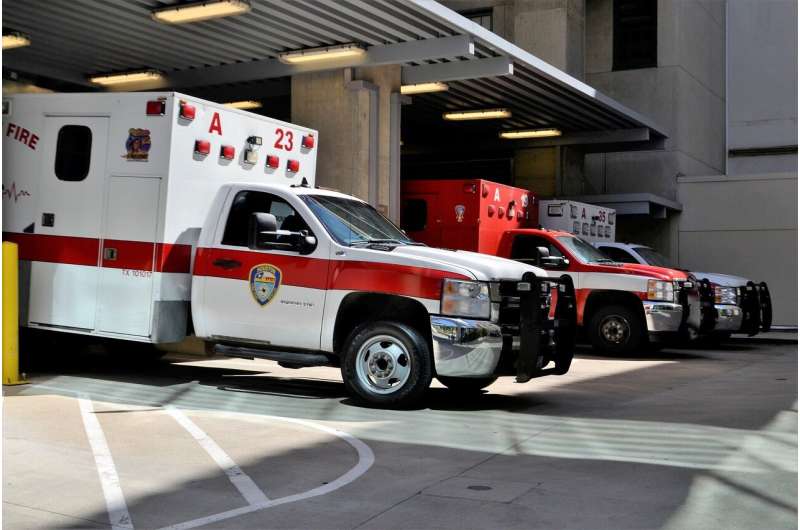Eye movement therapy helps first responders deal with harsh realities of their jobs

The scent of sage adds a sense of calm to the room, and three small lamps cast a soft glow. The high-backed office chair looks inviting and comfy.
Yet when Jon Nessel sits down, he cannot relax. One jeans-covered knee bounces, the heel of his work boot tap-tap-tapping against the floor. The sunglasses he fidgets with suddenly seem more interesting than the psychologist beside him. He cracks every knuckle.
Brian Barkett leans in and asks Nessel what memory he wants to work on today. Nessel offers just one word, the name of a baby girl who died during his recent emergency room shift at a Columbus hospital.
Barkett begins: "OK. Where's the damage?"
"That I couldn't save her," Nettles answers.
"What would you rather have in your mind?" Barkett asks this time.
"That I did my best," Nessel says.
"OK, good," Barkett says. "Let's go with that."
A couple of more questions, then Barkett hits a switch and a small blue dot pops up on the screen of the iPad that is positioned on a stand in front of Nessel. From the upper left corner to the lower right corner the dot travels. Back and forth. Back and forth. Back and forth.
A pause. A few more probing questions. Then quiet, and the dot starts sliding diagonally again. Nessel follows it with his gaze.
This is eye movement desensitization and reprocessing, a psychotherapy that's been around since at least the 1990s but one that has exploded in use in recent years, especially for those suffering trauma.
Almost all of Barkett's patients at his Better Minds Group practice in Granville are first responders.
EMDR, as it is commonly called, isn't easily explained. Barkett boils it down like this: While specific memories are in our brains, the rapid eye movement helps stimulate and synchronize the frontal and temporal lobes, retraining the brain to dim the memory and help our bodies recognize it is no longer an immediate threat. And that allows our natural fight-or-flight instinct to tamp down. The fear disappears.
Nessel doesn't care why it works. He just knows that it does. A 52-year-old former police officer who worked Chicago's roughest South Side precincts and now serves as a paramedic/firefighter and lives in Granville, he's found the treatments have faded his ugly memories, reduced his nightmares, eased his anxiety.
"It's not normal to push on somebody's chest and hope they get their life back. It's not normal to look at a child's face and watch the light in their eyes go out," Nessel said.
"This," he said of EMDR, "lifts the fear and the pain away from me."
Some clients—those with a recent, single trauma, like experiencing a personal assault or witnessing a violent crash—might only need one session.
For those with old, lingering or repeated traumas, it can be more.
Dr. Brooke Donaldson deals with both. A former EMT/firefighter, she is now an emergency room physician at Genesis Hospital in Zanesville and a trauma doctor for the LifeFlight emergency medical helicopter service. No day is routine. Every moment in her work schedule is life or death.
And a couple of years ago, while on an anniversary trip with her husband, it all came crashing down.
"I was at my breaking point, at the brink of suicide," the 34-year-old doctor said. "I needed help."
A fellow firefighter recommended she try EMDR. She's been having regular sessions for almost a year now. Sometimes, she said, she leaves Barkett's office feeling renewed, relieved and unburdened. Other times, when the traumas they have been discussing are long suppressed and deep, not so much.
"We work through childhood traumas that have never been explored," Donaldson said. "That's complex and takes more time."
She is a leader in the movement to normalize things for doctors, nurses, paramedics and law-enforcement officers needing help.
Donaldson will in May move to Licking Memorial Hospital in Newark, and part of her duties will be establishing a peer-based team focused on helping medical professionals focus on self-care and coping with trauma.
"People don't get what we go through. Even our families don't get it," she said. "But we are starting to break that gap."
EMDR can really be done with simple tools: waves of the hand, the iPad dot, a moving light. But experts insist it is not hypnosis.
An article written in a respected science magazine in 2012 explained how it was growing in use even then and likened it to the reset that happens during deep sleep (the REM, rapid-eye movement stage.)
"In conjunction with their therapists, EMDR clients also learn to replace negative thoughts (such as 'I'll never get this job') with more positive thoughts (such as 'I can get this job if I try hard enough')," the story in Scientific American said.
Barkett has embraced the method for decades.
"We're living in an increasing winner-takes-all society. Push, push, push, push," he said. "After a while, your energy shifts to threat perception, that the world is a dangerous place. And your brain gets tired of being on guard. And a tired brain means depression. We have to learn to reset."
For Nessel, that means welcoming any therapy that takes care of his heart, mind and soul.
"A friend told me 'What you do isn't normal. No one wants to hear your stories,'" he said. "People tell us all the time 'You did a great job.' But yeah, the person I tried to save is dead. We need help to reconcile that. We need help."
©2020 The Columbus Dispatch (Columbus, Ohio)
Distributed by Tribune Content Agency, LLC.




















